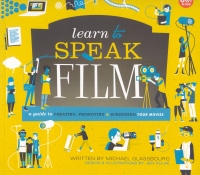| ________________
CM . . .
. Volume XX Number 17. . . .January 3, 2014
excerpt:
Lights, camera, action! In this final book of the “Learn to Speak” series, there is much for budding Spielbergs and Scorceses to digest. Author Michael Glassbourg knows of what he writes: he has taught film and television production at Humber College for more than 20 years and has over 30 years of experience writing, directing and producing films. In six well-developed chapters, he takes readers through all of the steps involved in creating a movie, from the initial germ of an idea for a story to postproduction and marketing. The first chapter introduces readers to the world of film and its basic formula (images + motion = film), describes the power of a film to elicit emotion through the use of sound, characters, stories, and setting, and gives a brief history of film in conjunction with advances in technology and some of the pioneers in film-making. This chapter also includes ideas for where to find inspiration for a good story. Glassbourg encourages readers to start small by using still photography to get the right composition, frame, light, and even the right moment to capture a photograph. The importance of lighting to create mood and atmosphere and to give a person character is discussed along with the different types of lighting and motion. Writing a strong script takes time and is well worth the effort for the script is the foundation of the film. Glassbourg explains the many parts of a screenplay and its structure and offers tips for writing dialogue. He advises writers to “show, not tell” and to ask for family and friends to take on the roles of the characters and read the script aloud in order to test the script. This step is crucial in that it allows the screenwriter to get a sense of the characters, dialogue and structure and also guides the rewriting process. Storyboards, too, are helpful. Once the final screenplay is ready, the film-maker organizes everything (script, storyboard, script breakdown, budget and any special notes) into a production binder. Glassbourg offers advice on how to work with the cast and crew in a professional manner and describes a professional film set. Readers will find interesting all of the post-production details that are integral to the creation of a successful film. Editing, adding the soundtrack and sound effects, checking for dialogue clarity, recreating sounds, such as footsteps, that were not recorded at the time of filming (this task is called Foley), mixing, adding computer-generated visual effects (VFX) and putting in all of the credits are just some of the tasks which must be done before test screening. Finally, there is marketing and publicity which take many forms, from still photos, trailers, posters and EPKs (Electronic Press Kits) to creating a web site, using social media and attending film festivals to promote the film. At the end of the book is a “Roll the Credits” section which profiles dozens of careers in the film industry in a variety of departments- camera, art, production, post-production and sound. Throughout the book, Glassbourg also includes quotes from seasoned experts in the industry- casting directors, storyboard artists and composers, just to name a few- that provide different perspectives and will inspire young film-makers. The book’s conversational writing style, the abundance of information and helpful hints, and the visually appealing layout and illustrations are guaranteed to attract film buffs and wannabe movie-makers. A table of contents and an index are included. Learn to Speak Film is one of the best books in the series! Highly Recommended. Gail Hamilton, a former teacher-librarian, lives in Winnipeg, MB.
To comment
on this title or this review, send mail to cm@umanitoba.ca.
Copyright © the Manitoba Library Association. Reproduction for personal
use is permitted only if this copyright notice is maintained. Any
other reproduction is prohibited without permission.
NEXT REVIEW |
TABLE OF CONTENTS FOR THIS ISSUE
- January 3, 2014.
AUTHORS |
TITLES |
MEDIA REVIEWS |
PROFILES |
BACK ISSUES |
SEARCH |
CMARCHIVE |
HOME |
